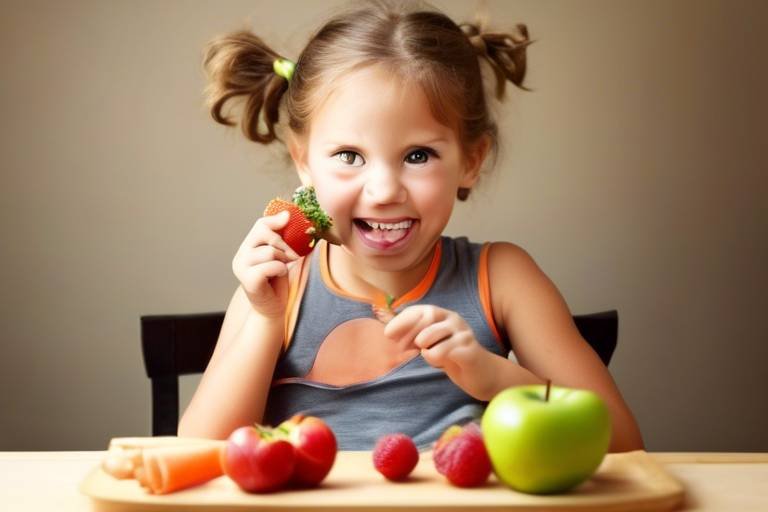Tips for Teaching Your Kids about Nutrition
As parents, we often find ourselves in a whirlwind of responsibilities, from managing work to juggling family time. In the midst of this chaos, one crucial aspect that deserves our attention is teaching our kids about nutrition. You see, instilling healthy eating habits at an early age can set the stage for a lifetime of good choices. But how do we make this learning process engaging and effective? Well, buckle up, because we’re about to dive into some practical strategies that can transform your kitchen into a vibrant classroom where nutrition becomes second nature!
First things first, let’s break down the nutritional basics. Teaching your kids about the different food groups is essential. Think of it as building a house; the foundation has to be solid. Start by introducing them to the major food groups: fruits, vegetables, grains, proteins, and dairy. Each group plays a vital role in their growth and development. For instance, fruits and vegetables are packed with vitamins and minerals that boost their immune system, while proteins are crucial for muscle development.
Moreover, explaining the concept of macronutrients (carbs, proteins, and fats) and micronutrients (vitamins and minerals) can help them appreciate the importance of balanced meals. A simple analogy can be likened to a car; just like a car needs fuel, oil, and maintenance to run smoothly, our bodies require a balanced intake of nutrients to function optimally.
Now, let’s talk about how we can make this learning process enjoyable. Engaging kids in cooking and gardening can turn the serious topic of nutrition into a fun adventure! Imagine the excitement on their faces as they plant seeds, water them, and eventually harvest fresh veggies. It’s not just about the food; it’s about the experience! These hands-on activities reinforce healthy eating habits and foster a love for nutritious foods.
Involving children in meal preparation can spark their interest in food. Cooking together is like a mini science experiment; they get to see how different ingredients combine to create something delicious. Plus, it allows them to learn about the nutritional value of what they are eating. You can make it even more exciting by letting them choose a recipe or two. Imagine the pride they’ll feel when they serve a dish they helped create!
When selecting recipes, aim for simple, healthy options that kids can easily help with. Think of colorful stir-fries, homemade pizzas topped with their favorite veggies, or smoothies packed with fruits. This encourages them to explore new flavors and understand the nutritional value of different foods. The more involved they are, the more likely they are to enjoy and appreciate the food they eat.
Of course, we can’t forget about kitchen safety. Teaching kids how to handle utensils and ingredients properly is crucial. Make it a fun learning experience by creating a “safety checklist” together. This not only ensures a safe cooking environment but also empowers them to feel confident in the kitchen.
Starting a small garden is another fantastic way to teach kids about nutrition. It’s like a treasure hunt where the treasure is fresh produce! Gardening instills a sense of responsibility and appreciation for where their food comes from. Watching something grow from a tiny seed to a full-blown vegetable is a magical experience that can deepen their understanding of nutrition.
Promoting healthy eating habits involves guiding kids in making better food choices. But how do we do that without sounding preachy? The answer lies in encouragement and positive reinforcement. Celebrate their healthy choices, whether it’s choosing a piece of fruit over a candy bar or trying a new vegetable. This creates a positive association with nutritious foods and encourages them to develop a lifelong appreciation for healthy eating.
Remember, kids are like sponges; they absorb everything around them. If they see you enjoying a colorful salad or munching on carrot sticks, they’re more likely to follow suit. By modeling healthy eating behaviors, you can effectively influence their food choices and attitudes toward nutrition.
Establishing regular meal and snack times helps children develop a healthy eating routine. Think of it as setting the stage for a show; when the curtain rises at mealtime, everyone knows their role. Consistency fosters better food choices and reduces the likelihood of unhealthy snacking. Plus, it creates a sense of stability that kids thrive on.
- What are some easy recipes to start with? Simple recipes like smoothies, vegetable stir-fries, and homemade pizzas are great starting points.
- How can I make vegetables more appealing to my kids? Try involving them in the cooking process and experimenting with different flavors and dips.
- What if my child refuses to try new foods? Encourage them to take just one bite and praise their efforts. Gradually, they may become more open to trying new things.

Understanding Nutritional Basics
Teaching kids the basic food groups and their benefits can lay a strong foundation for healthy eating. When children understand the importance of nutrition, they can make informed food choices that positively impact their growth and development. It's not just about filling their plates; it's about filling their minds with knowledge about what they eat. Just like a car needs the right fuel to run efficiently, our bodies require a balanced diet to function optimally.
To start, let’s break down the essential food groups that every child should be familiar with:
| Food Group | Examples | Benefits |
|---|---|---|
| Fruits | Apples, Bananas, Berries | Rich in vitamins, minerals, and fiber |
| Vegetables | Carrots, Spinach, Broccoli | High in nutrients and low in calories |
| Grains | Whole wheat bread, Brown rice, Oats | Source of energy and essential nutrients |
| Proteins | Chicken, Fish, Beans | Important for growth and muscle development |
| Dairy | Milk, Yogurt, Cheese | Rich in calcium for strong bones |
Understanding macros and micros is also crucial. Macros, or macronutrients, include carbohydrates, proteins, and fats, while micros, or micronutrients, encompass vitamins and minerals. Each plays a vital role in maintaining health:
- Carbohydrates provide energy, fueling everything from playtime to homework.
- Proteins are essential for growth and repair of tissues, making them vital for growing children.
- Fats are important for brain development and hormone production.
Encouraging kids to appreciate the nutritional value of their food can be an exciting journey. You might ask them questions like, "What do you think this food does for your body?" or "How do you feel after eating this?" These questions not only engage them but also promote critical thinking about their food choices. By involving them in discussions about nutrition, you’re helping them cultivate a lifelong appreciation for healthy eating.
In conclusion, laying the groundwork for understanding nutritional basics is essential for fostering healthy eating habits in children. The earlier they learn about the food groups, the better equipped they will be to make nutritious choices as they grow. So, let’s make nutrition a fun and exciting topic, one meal at a time!

Incorporating Fun Activities
When it comes to teaching kids about nutrition, one of the most effective strategies is to make it fun. Engaging children in activities that involve food can turn the learning process into an exciting adventure. Think about it: how often do kids remember lessons that are dry and boring? Instead, by incorporating hands-on experiences, you can create lasting memories while instilling healthy habits. So, how can you make nutrition education enjoyable? Let’s dive into some creative ideas!
One fantastic way to get kids involved is by cooking together. Imagine the joy on their faces as they mix, stir, and taste their creations! When children participate in meal preparation, they not only learn about different ingredients but also develop essential life skills. Cooking can become a delightful family bonding time, where laughter and learning go hand in hand. It's a chance to talk about the nutritional value of each ingredient and why they matter. For instance, you could explain how vegetables are packed with vitamins that help them grow strong and healthy.
Now, what about the recipes? Selecting simple, healthy options is key. Think of meals that allow kids to take the lead, like homemade pizzas or fruit salads. Not only are these dishes fun to make, but they also encourage kids to explore new flavors and textures. You might even consider creating a weekly family recipe night, where each member gets to pick a healthy dish to prepare together. This not only makes cooking exciting but also gives children a sense of ownership over their meals.
Of course, with great fun comes great responsibility! It’s crucial to teach kids about kitchen safety while they’re cooking. Start by showing them how to properly handle utensils and ingredients. For example, explain the importance of washing hands before touching food, or how to safely use a knife with supervision. By instilling these safety habits early on, you ensure that cooking remains a safe and enjoyable experience for everyone involved.
Another exciting way to teach kids about nutrition is through gardening. Starting a small garden at home can be a transformative experience. Imagine your children planting seeds, watering them, and watching them grow into fresh vegetables and fruits. This not only teaches them where their food comes from but also instills a sense of responsibility. Plus, there’s something magical about eating produce that they’ve nurtured themselves. It enhances their appreciation for fresh food and encourages them to try new things.
Incorporating these fun activities into your routine can make a world of difference in how your children perceive food and nutrition. By engaging them in cooking and gardening, you’re not just teaching them about healthy eating; you’re creating lasting memories that will resonate throughout their lives. So, why not roll up your sleeves and dive into the world of nutrition together? It’s not just about food; it’s about building a healthy future!
- How can I get my kids interested in cooking? Start with simple recipes that are fun and interactive, allowing them to take part in the process.
- What are some easy gardening projects for kids? Consider planting herbs, radishes, or cherry tomatoes, which grow quickly and can be exciting for children to watch.
- How do I teach my kids about nutrition without overwhelming them? Keep it simple! Focus on one food group at a time and use engaging activities to reinforce the lessons.

Cooking Together
Cooking together with your kids is not just about preparing meals; it's an adventure that can ignite their curiosity about food and nutrition. Imagine the joy of creating a delicious dish as a team, laughing, and bonding over the mixing of ingredients! When children are involved in the kitchen, they are more likely to develop a positive relationship with food. It's like turning a mundane task into a fun-filled family activity!
When you invite your children into the kitchen, you're not just teaching them how to cook; you're also imparting valuable life skills. From measuring ingredients to understanding cooking times, each step is a lesson in itself. Plus, it’s a fantastic opportunity to talk about the nutritional value of the foods you’re preparing. For instance, while chopping vegetables, you can discuss how they are packed with vitamins and minerals that help keep their bodies strong and healthy. This hands-on experience can turn abstract concepts of nutrition into tangible knowledge.
To make the cooking experience even more engaging, consider choosing recipes that are simple yet enjoyable. Here are a few ideas:
- Homemade Pizza: Let your kids choose their toppings! This allows them to explore various vegetables and proteins.
- Fruit Smoothies: A great way to introduce fruits! Kids can select their favorite fruits and learn about the health benefits of each.
- DIY Tacos: Encourage them to fill their tacos with colorful veggies, beans, and lean meats, making it a fun and nutritious meal.
While cooking, don't forget to incorporate kitchen safety. Teach your kids how to handle utensils properly and the importance of washing their hands before starting. You might say, “Just like superheroes need to wear their capes to protect themselves, we need to follow safety rules in the kitchen!” This not only keeps them safe but also instills a sense of responsibility.
Finally, remember that the goal is to have fun! If things don’t go as planned—if the cake doesn’t rise or the pasta gets a bit overcooked—embrace it! Use these moments to teach resilience and creativity. After all, cooking is as much about the journey as it is about the destination. So roll up those sleeves, put on your aprons, and create delicious memories together!
Q: What age is appropriate for kids to start cooking?
A: Kids can start helping in the kitchen as young as 2 or 3 years old with simple tasks like washing vegetables. As they grow, they can take on more complex activities.
Q: How can I make cooking together more educational?
A: Use cooking as a way to teach math (measuring ingredients), science (mixing and cooking processes), and nutrition (discussing food groups and health benefits).
Q: What if my child is a picky eater?
A: Involve them in the cooking process! They may be more willing to try new foods if they helped prepare them.
Q: How can I ensure kitchen safety for my kids?
A: Teach them the basics of kitchen safety, like how to handle knives properly, the importance of washing hands, and being cautious around hot surfaces.

Choosing Recipes
When it comes to choosing recipes that will not only nourish your kids but also engage them in the kitchen, simplicity is key. Think of recipes as the building blocks of your culinary adventure together. You want to select dishes that are not just healthy, but also fun and easy for kids to help prepare. Imagine whipping up a colorful vegetable stir-fry or a fruity smoothie; these are not just meals, they are opportunities for creativity and learning!
Start by considering recipes that incorporate a variety of food groups, ensuring that your children are getting a balanced meal. For instance, you might choose a recipe that includes:
- Fruits: Fresh berries, bananas, or apples can add natural sweetness and vibrant colors.
- Vegetables: Carrots, bell peppers, and spinach can introduce essential vitamins and minerals.
- Whole Grains: Brown rice, quinoa, or whole grain pasta can provide the necessary energy.
- Proteins: Chicken, fish, beans, or tofu can help in building strong muscles.
Another fun idea is to involve your kids in the recipe selection process. You can create a "recipe board" where they can pin their favorite dishes or even draw pictures of meals they want to try. This not only gives them a sense of ownership but also sparks their curiosity about different ingredients. Plus, it’s a great way to teach them about nutrition by discussing the benefits of each ingredient as you go along.
Don't forget about the importance of flavor! Kids are more likely to enjoy meals that are not just healthy but also delicious. Encourage your little chefs to experiment with herbs and spices. For example, adding a sprinkle of cinnamon to oatmeal or a dash of garlic powder to roasted vegetables can elevate the dish and make it more appealing. It's all about making healthy eating an exciting adventure, rather than a chore.
Lastly, consider the time commitment. Choose recipes that fit your schedule. Quick meals, like a 15-minute veggie wrap or a 30-minute pasta dish, can be perfect for busy weeknights. Remember, the goal is to create a positive cooking experience that leaves everyone feeling accomplished and satisfied. So, roll up those sleeves, gather the ingredients, and let the cooking fun begin!
Q: How can I make cooking more appealing for my kids?
A: Involve them in the process! Let them choose recipes, measure ingredients, and even decorate the finished dish. This creates a sense of ownership and excitement around food.
Q: What are some easy recipes to start with?
A: Start with simple recipes like smoothies, veggie wraps, or homemade pizzas where kids can choose their toppings. These are not only easy but also allow for creativity!
Q: How do I ensure my kids are eating healthy?
A: Focus on whole foods and involve your kids in meal planning. Discuss the nutritional benefits of different ingredients, and encourage them to try new foods without pressure.

Kitchen Safety
When it comes to cooking with your kids, should be your top priority. After all, the kitchen can be a bustling hub of activity, filled with sharp knives, hot stoves, and slippery floors. To ensure a fun and safe cooking experience, it’s essential to educate your children about the potential hazards and the precautions they need to take. Start by discussing the importance of cleanliness in the kitchen. Teach them to wash their hands thoroughly before handling any food, as this simple step can prevent the spread of germs and keep everyone healthy.
Next, introduce your kids to the various kitchen tools they’ll be using. Explain the purpose of each item, especially the ones that can be dangerous. For instance, knives should always be handled with care. You might say, “Think of a knife as a superhero's sword; it can help create delicious meals, but if used recklessly, it can cause harm.” Demonstrating the proper way to hold and use a knife can help them understand the importance of caution.
Additionally, you can create a kitchen safety checklist that your kids can refer to every time they cook. This checklist can include:
- Always ask an adult for help when using sharp objects.
- Use oven mitts when handling hot pots and pans.
- Keep the cooking area clean and free of clutter.
- Never leave cooking food unattended on the stove.
Another critical aspect of kitchen safety is understanding how to deal with spills and messes. Encourage your children to clean up any spills immediately to prevent slips and falls. You can even make it a fun game: “Let’s see who can clean up the fastest!” This not only keeps the kitchen safe but also teaches them responsibility.
Finally, remember to maintain a calm and focused atmosphere while cooking. If your child is feeling overwhelmed or distracted, it can lead to accidents. Encourage them to take their time and enjoy the process. A safe kitchen is a happy kitchen, and by instilling these safety practices, you’ll help your kids develop a lifelong appreciation for cooking.
Q: What age is appropriate for children to start cooking?
A: Children as young as 4 can begin with simple tasks like mixing ingredients, while older kids (around 8-10) can handle more complex tasks with supervision.
Q: How can I make cooking safer for my kids?
A: Always supervise them, teach them about kitchen tools, and create a safety checklist for them to follow.
Q: What are some good beginner recipes for kids?
A: Start with simple recipes like smoothies, sandwiches, or no-bake desserts that allow them to practice their skills without too much risk.

Gardening as a Learning Tool
Gardening is not just a hobby; it's a fantastic educational tool that can provide children with a wealth of knowledge about nutrition, responsibility, and the environment. Imagine your kids digging their hands into the soil, planting seeds, and watching them grow into vibrant vegetables or beautiful flowers. This hands-on experience is invaluable, as it teaches them where their food comes from and the effort that goes into growing it. By nurturing plants, children develop a sense of responsibility and learn the importance of caring for living things.
When kids participate in gardening, they become more aware of the foods they consume. They learn about the life cycle of plants, the importance of biodiversity, and how different plants contribute to a balanced diet. For instance, they can understand that leafy greens like spinach and kale are packed with nutrients, while colorful fruits like tomatoes and peppers provide essential vitamins. This knowledge can foster a deeper appreciation for fresh produce and encourage them to make healthier food choices.
Additionally, gardening can be a wonderful way to introduce children to the concept of seasonality. They will discover that certain fruits and vegetables are only available during specific times of the year, which can lead to discussions about local farming and the benefits of eating seasonal produce. By understanding these concepts, children can develop a more sustainable mindset regarding food consumption.
To make gardening even more engaging, consider creating a small garden space at home or participating in a community garden. Here are some tips to get started:
- Choose the Right Location: Look for a sunny spot in your yard or community garden where plants can thrive.
- Start Small: Begin with easy-to-grow plants like tomatoes, radishes, or herbs. This will keep your kids motivated as they see quick results.
- Incorporate Learning: Use gardening as a way to teach kids about science, math, and even art. For example, they can measure plant growth or create garden decorations.
In summary, gardening is an engaging and educational activity that can profoundly impact children's understanding of nutrition. It not only teaches them about food but also instills values of patience, hard work, and respect for nature. As they watch their plants grow and eventually harvest the fruits of their labor, they will likely develop a lifelong love for healthy foods and a strong connection to the earth.
Q: What age is appropriate for children to start gardening?
A: Children as young as 3 can start gardening with supervision. They can help with simple tasks like planting seeds or watering plants. As they grow older, they can take on more responsibilities.
Q: What are some easy plants for kids to grow?
A: Some easy plants include radishes, lettuce, herbs like basil or mint, and sunflowers. These plants grow quickly and are rewarding for children.
Q: How can I make gardening fun for my kids?
A: Incorporate games, such as scavenger hunts for garden items, or allow them to decorate their garden space. You can also create a gardening journal to track their plants' growth.
Q: Can gardening help improve my child's eating habits?
A: Yes! Research shows that children who grow their own food are more likely to eat fruits and vegetables. Gardening can spark their interest in trying new foods.

Encouraging Healthy Choices
Promoting healthy eating habits is not just about telling kids what to eat; it’s about guiding them in making better food choices that will last a lifetime. Think of it as planting seeds in a garden—nurturing them with knowledge and encouragement allows them to blossom into healthy eating habits. One of the most effective ways to achieve this is through positive reinforcement. When children make healthy choices, celebrate those moments! Whether it's a high-five or a special dinner, acknowledging their efforts can motivate them to continue making nutritious decisions.
Another key aspect is to create an environment that encourages healthy eating. Stock your pantry with a variety of nutritious snacks and meals. Instead of chips and sugary treats, fill it with fruits, nuts, and whole-grain options. This way, when your children reach for a snack, they are more likely to choose something healthy. You can also involve them in the shopping process. Let them pick out fruits and vegetables at the grocery store. This not only makes them feel included but also teaches them about making healthy food choices from a young age.
Additionally, it's important to provide education about nutrition in a fun and engaging way. You could create a game where kids earn points for trying new healthy foods or learning about different food groups. For instance, you might say, "For every new fruit you try, you earn a point!" This gamification can make the learning process exciting and less of a chore.
Modeling healthy behaviors is crucial as well. Kids are like little sponges, soaking up everything they see. If they see you reaching for a salad instead of junk food, they’re likely to follow suit. Share your own experiences with healthy eating—talk about how good you feel after eating a balanced meal or how much energy you have when you choose nutritious snacks. It’s all about creating a culture of health within your home.
To further enhance their understanding, you can introduce them to the concept of food variety. Explain how different foods contribute different nutrients to their bodies. For example, you might say, "Carrots are great for your eyes, while bananas give you energy." This not only makes them aware of the benefits but also encourages them to try a wider range of foods. You could even create a colorful chart that showcases various foods and their benefits, making it visually appealing and easy to understand.
Remember, the goal is to foster a positive relationship with food. Instead of labeling foods as 'good' or 'bad', encourage a balanced approach. Teach them that it’s okay to enjoy treats in moderation. This way, they won’t feel deprived and will be less likely to rebel against healthy eating as they grow older.
Incorporating these strategies into your daily routine can create a nurturing environment where healthy choices are the norm. It’s about making nutrition a fun and integral part of their lives, ensuring they grow up with the knowledge and skills to make informed food choices. So, let’s dig in and cultivate those healthy habits together!
- How can I get my child to eat more vegetables? Try incorporating vegetables into their favorite dishes or making them fun shapes. Involving them in meal prep can also spark their interest.
- What are some healthy snacks for kids? Fruits, yogurt, nuts, and whole-grain crackers are great options. Make sure to keep a variety on hand!
- How do I explain nutrition to my child? Use simple language and relatable examples. Turn it into a game or a fun activity to keep their interest.

Modeling Behavior
When it comes to teaching kids about nutrition, one of the most powerful tools in your arsenal is . Children are like sponges; they absorb everything around them, especially the actions and habits of their parents. If you want your little ones to embrace healthy eating, it’s crucial to lead by example. This means not just talking the talk but also walking the walk. Have you ever noticed how kids tend to mimic their parents? If they see you enjoying a colorful salad or snacking on fruits instead of chips, they’re more likely to want to try those foods themselves.
But it’s not just about what you eat; it’s also about how you talk about food. If you constantly express disdain for vegetables or label certain foods as “bad,” your kids will pick up on that negativity. Instead, try to frame food choices in a positive light. For instance, you might say, “Let’s make a delicious smoothie with spinach and bananas!” This not only introduces them to new flavors but also helps them associate healthy foods with fun experiences.
Another important aspect of modeling behavior is involving your kids in your eating habits. Family meals are a great opportunity to showcase healthy choices. Try to make it a point to sit down together as a family for dinner. During these meals, discuss the dishes you’ve prepared and why they’re nutritious. You could say, “This quinoa is full of protein, and these roasted veggies are packed with vitamins!” Engaging them in conversation about food not only educates them but also makes them feel included.
Additionally, consider the environment you create around food. If you keep a bowl of fresh fruits on the counter, it serves as a visual reminder of healthy snacking options. On the other hand, if junk food is easily accessible, it can be tempting for kids to reach for those items instead. It’s all about creating a positive food environment that encourages healthy choices. Remember, it’s not just about nutrition; it’s about instilling a lifestyle that values health and well-being.
In summary, modeling behavior is an invaluable strategy in teaching your children about nutrition. By demonstrating healthy eating habits, speaking positively about food, and creating a supportive environment, you can set your kids on the path to a lifetime of healthy choices. Remember, you are their first teacher, and your actions speak louder than words!
- What are some effective ways to model healthy eating for my kids?
Involve them in meal planning and preparation, share your positive experiences with healthy foods, and maintain a balanced diet yourself. - How can I encourage my kids to try new foods?
Make trying new foods a fun family activity, and don’t pressure them. Offer new foods alongside familiar favorites. - What if my child refuses to eat healthy foods?
Be patient and persistent. Offer healthy options regularly without forcing them, and celebrate their small victories in trying new foods.

Setting a Routine
Establishing a consistent routine for meals and snacks is a game changer when it comes to teaching kids about nutrition. Think of it like building a house; without a solid foundation, everything else can come crumbling down. By setting regular meal times, you create a predictable environment that helps children understand when to expect food, which can significantly reduce the urge to snack mindlessly throughout the day.
Imagine a day where breakfast, lunch, and dinner are like clockwork. Kids know that breakfast is at 8 AM, lunch at noon, and dinner at 6 PM. This predictability not only helps them feel secure but also encourages them to listen to their bodies and recognize their hunger cues. When kids are aware of when their next meal is coming, they are less likely to graze on unhealthy snacks in between. It’s like training a puppy; consistency is key!
Moreover, setting a routine can also foster a sense of family bonding. Meal times become an opportunity for everyone to sit down together, share their day, and enjoy healthy food. You can even make it a fun tradition, like Taco Tuesdays or Smoothie Sundays, which adds an element of excitement to healthy eating. Kids look forward to these moments, and it reinforces the idea that eating together is not just about nourishment, but also about connection.
To make this routine work effectively, consider the following tips:
- Plan Ahead: Take some time each week to plan meals and snacks. This helps in making healthier choices and reduces last-minute unhealthy options.
- Involve Your Kids: Let them help choose meals or snacks for the week. When kids have a say in what they eat, they are more likely to be excited about it.
- Be Flexible: While routines are important, it’s also crucial to remain adaptable. Life happens! If a family event disrupts the schedule, don’t stress. Just get back on track as soon as possible.
Finally, remember that patience is vital. Developing a healthy eating routine takes time, and it’s normal for kids to resist at first. Just like teaching them to ride a bike, they may wobble and fall a few times before they get it right. But with encouragement and consistency, they will learn to appreciate the benefits of healthy eating habits that last a lifetime.
Q: How can I encourage my child to stick to the eating routine?
A: Positive reinforcement is key! Celebrate small victories, and offer praise when they make healthy choices. You can also involve them in the planning process, which gives them a sense of ownership over their food choices.
Q: What if my child refuses to eat healthy foods?
A: It’s essential to keep offering a variety of healthy foods without pressure. Kids often need to be exposed to a new food multiple times before they accept it. Make it fun by presenting food in creative ways or involving them in the cooking process.
Q: How can I balance routine with the occasional treat?
A: Balance is crucial! Allowing occasional treats can make healthy eating more enjoyable and sustainable. Just ensure that treats are an exception rather than the rule, and always encourage moderation.
Frequently Asked Questions
- What are the basic food groups I should teach my kids about?
It's essential to introduce your kids to the five basic food groups: fruits, vegetables, grains, protein, and dairy. Each group has unique benefits that contribute to a balanced diet. For instance, fruits and vegetables provide vital vitamins and minerals, while grains offer energy. By understanding these groups, kids can make informed choices about their meals.
- How can I make learning about nutrition fun for my children?
Engaging activities like cooking together or starting a small garden can make learning about nutrition enjoyable. When kids actively participate in preparing meals or growing their own vegetables, they develop a deeper appreciation for healthy foods. Plus, these activities can spark curiosity and creativity in the kitchen!
- What are some simple recipes I can cook with my kids?
Look for easy, healthy recipes that require minimal steps and ingredients. Think along the lines of smoothies, veggie stir-fries, or homemade pizzas where they can choose their toppings. These recipes not only make cooking fun but also help kids learn about nutrition as they explore different flavors.
- How can I ensure kitchen safety when cooking with my kids?
Kitchen safety is crucial! Start by teaching them about proper handling of utensils and ingredients. Make sure they understand the importance of washing hands, handling knives carefully, and using appliances safely. Supervision is key, so always be nearby to guide them through the process.
- Why is gardening beneficial for teaching kids about nutrition?
Gardening helps kids understand where their food comes from and fosters a sense of responsibility. When they grow their own fruits and vegetables, they’re more likely to eat them. It’s a hands-on way to learn about nutrition while also appreciating the effort that goes into growing food!
- How can I encourage my kids to make healthier food choices?
Modeling healthy eating habits is one of the most effective ways to influence your children's choices. If they see you enjoying nutritious foods, they’re more likely to try them too. Additionally, establishing a routine for meals and snacks can help them develop a consistent approach to healthy eating.



















